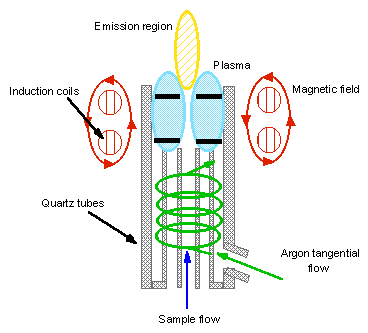
| The sample is nebulized and entrained in the flow of plasma support gas, which is typically Ar. The plasma torch consists of concentric quartz tubes, with the inner tube containing the sample aerosol and Ar support gas and the outer tube containing an Ar gas flow to cool the tubes (see schematic). A radiofrequency (RF) generator (typically 1-5 kW @ 27 MHz or 41 MHz) produces an oscillating current in an induction coil that wraps around the tubes. The induction coil creates an oscillating magnetic field, which produces an oscillating magnetic field. The magnetic field in turn sets up an oscillating current in the ions and electrons of the support gas. These ions and electrons transfer energy to other atoms in the support gas by collisions to create a very high temperature plasma. | Schematic cross-section of an ICP
 |
Auf diesem Webangebot gilt die Datenschutzerklärung der TU Braunschweig mit Ausnahme der Abschnitte VI, VII und VIII.